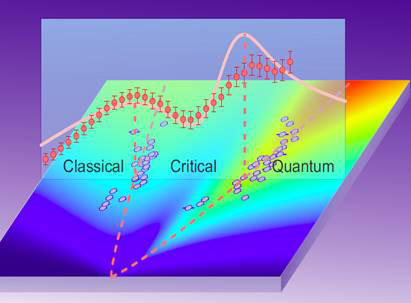The transition of quantum criticality between classical gases and quantum liquids within one-dimensional (1D) many-body system could be seen for the first time around the world by quantum integrable system and the control and measure of ultracold atoms in optical lattice, thanks to the joint cooperation between Professor YANG Bing, Professor PAN Jianwei, Professor YUAN Zhensheng and colleagues at the University of Science and Technology of China (USTC) and GUAN Xiwen team at Wuhan Institute of Physics and Mathematics, Chinese Academy of Sciences. Furthermore, a great stride was made in low-dimensional quantum many-body system because of the observation of power-law decay of Tomonaga-Luttinger liquid (TLL).
One-dimensional (1D) materials—from nanowires to carbon nanotubes to linear arrays of cold atoms—hold promise in nanoelectronics, sensing, energy harvesting, and quantum information processing. The TTL theory developed in the 1980s by physicist Frederick Duncan Haldane and his co-workers describes a 1D ensemble of interacting quantum particles in terms of TLL. It predicts properties of 1D quantum systems such as its superconductivity in low temperatures and how electrons behave in a nanowire. Quantum many-body phase transition features diverse quantum critical phenomena, and it has become a frontier in low-temperature physics in recent years. However, the observation of TTL features and quantum criticality and determination of the TLL boundary in 1D quantum gases remains elusive in condensed matter physics and cold atom physics because it is very difficult to control how particles interact in 1D systems experimentally such as nanowires.

Figure 1:Sketch of the experimental setup used by Yang et al. Arrays of rubidium-87 atoms, cooled and trapped by laser beams, exhibit Tomonaga-Luttinger liquid (TLL) behavior.(Adapted from B. Yang et al. [2] by APS/Alan Stonebraker)
Now, YANG Bing, YUAN Zhensheng and PAN Jianwei, and co-workers have shown TLL behavior in a 1D array of cold atoms, establishing cold atoms as a reliable platform for simulating some aspects of TLL physics that might be hard to access in condensed-matter systems. They circumvent some of these difficulties by using a clever experimental setup based on 1D arrays of laser-trapped, ultracold rubidium-87 atoms (see Fig. 1). With a resonant light pulse they remove atoms from the middle of the arrays, generating a density oscillation that moves outwards from the center of the array. Their experiment begins with a regular 1D array of rubidium-87 atoms trapped in an optical lattice of laser light. A laser pulse is then used to eject atoms from the central region of the trap, which sets off a density wave that moves outwards from the center of the trap. The atomic density in the central region of the trap becomes nearly uniform, thus providing a homogeneous analogue to a TLL.
By measuring the density and speed of sound in the central region, the team could work out the "TLL parameter" which measures the level of quantum fluctuations in the system. YANG, PAN and colleagues then measured the momentum distribution in the system and confirmed that it matched TTL model. In the nonuniform system, the momentum distribution that exhibits a power-law decay at intermediate momenta is well consistent with the TLL theory.

Figure 2:Phase diagram of 1D quantum many-body system(Image by PAN Jianwei)
Three regions-classical gases, quantum critical region and TLL- in a phase diagram are clearly defined in a double-peak structure of specific heat for the first time with experimental data (Fig. 2).
Finally, they compare TLL predictions with experimental data on the atoms’ momentum distribution. The good agreement between theory and experiments showe that TLL provides an excellent description of this 1D bosonic system.
The experiment provides prototypical methods for studying quantum critical phenomena and quantum liquids, not only in spinless quantum gases but also in quantum many-body systems involving rich spin (and charge) interactions and symmetries, such as spin chains, the Yang-Gaudin model, and the Hubbard model.
“By providing a remarkable experimental demonstration of several so-far-elusive aspects of TLL theory, these two new studies confirm that TLL theory now plays the same key role in 1D systems that Fermi-liquid theory plays in our understanding of 2D and 3D condensed-matter systems. Without a doubt, this research will open new chapters in the TLL field by inspiring studies that examine how other perturbations (coupling between different 1D chains, spin-orbit coupling, and the like) can lead to novel and potentially exotic states in 1D materials.” Professor Giamarchi comments.
This research is published in Physical Review Letters and has been selected as Editors’ Suggestion. Professor Thierry Giamarchi from the Department of Quantum Matter Physics of University of Geneva has been invited by Physics to review on the research in its column Viewpoint titled as “The Tomonaga-Luttinger theory describing one-dimensional materials has been tested with cold atoms and arrays of Josephson junctions”. Physicsworld reports the research titled as “Atoms and Josephson junctions simulate 1D quantum liquid”.
This work has been supported by the National Key R&D Program of China, the NNSFC, the Chinese Academy of Sciences and other institutions.
See more of the paper at:https://journals.aps.org/prl/abstract/10.1103/PhysRevLett.119.165701
Column review in Physics: https://physics.aps.org/articles/v10/115
Report in Physicsworld: http://physicsworld.com/cws/article/news/2017/oct/19/atoms-and-josephson-junctions-simulate-1d-quantum-liquid
Contact:
Prof. GUAN Xiwen
State Key Laboratory of Magnetic Resonance and Atomic and Molecular Physics, Wuhan Institute of Physics and Mathematics, Chinese Academy of Sciences
xiwen.guan@anu.edu.au
Prof. YUAN Zhensheng
Hefei National Laboratory for Physical Sciences at Microscale and Department of Modern Physics, University of Science and Technology of China
yuanzs@ustc.edu.cn
Prof. PAN Jianwei
Hefei National Laboratory for Physical Sciences at Microscale and Department of Modern Physics, University of Science and Technology of China
pan@ustc.edu.cn